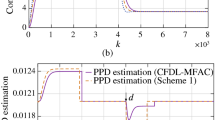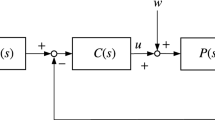Abstract
This paper presents a parameter formula connecting the well-known proportional-integral-derivative (PID) control and the active disturbance rejection control (ADRC). On the one hand, this formula gives a quantitative lower bound to the bandwidth of the extended state observer (ESO) used in ADRC, implying that the ESO is not necessarily of high gain. On the other hand, enlightened by the design of ADRC, a new PID tuning rule is provided, which can guarantee both strong robustness and nice tracking performance of the closed-loop systems under the PID control. Moreover, it is proved that the ESO can be rewritten as a suitable linear combination of the three terms in PID, which can give a better estimate for the system uncertainty than the single integral term in the PID controller. Theoretical results are verified also by simulations in the paper.
Similar content being viewed by others
References
Samad T. A survey on industry impact and challenges thereof. IEEE Control Syst, 2017, 37: 17–18
O’Dwyer A. PI and PID controller tuning rules: an overview and personal perspective. In: Proceedings of the IET Irish Signals and Systems Conference, 2006. 161–166
Åström K J, Hägglund T. PID Controllers: Theory, Design and Tuning. 2nd ed. Research Triangle Park: Instrument Society of America, 1995
Zhao C, Guo L. PID controller design for second order nonlinear uncertain systems. Sci China Inf Sci, 2017, 60: 022201
Zhang J K, Guo L. Theory and design of PID controller for nonlinear uncertain systems. IEEE Control Syst Lett, 2019, 3: 643–648
Han J Q. Auto-disturbance rejection control and its applications (in Chinese). Control Decis, 1998, 13: 19–23
Xue W C, Huang Y. Performance analysis of 2-DOF tracking control for a class of nonlinear uncertain systems with discontinuous disturbances. Int J Robust Nonlin Control, 2018, 28: 1456–1473
Chen S, Bai W Y, Hu Y, et al. On the conceptualization of total disturbance and its profound implications. Sci China Inf Sci, 2020, 63: 129201
Guo B Z, Zhao Z L. On the convergence of an extended state observer for nonlinear systems with uncertainty. Syst Control Lett, 2011, 60: 420–430
Sira-Ramírez H, Linares-Flores J, García-Rodríguez C, et al. On the control of the permanent magnet synchronous motor: an active disturbance rejection control approach. IEEE Trans Contr Syst Technol, 2014, 22: 2056–2063
Zheng Q, Gao Z Q. On practical applications of active disturbance rejection control. In: Proceedings of the 29th Chinese Control Conference, 2010. 6095–6100
Huang Y, Xue W C. Active disturbance rejection control: methodology and theoretical analysis. ISA Trans, 2014, 53: 963–976
Acknowledgements
This work was supported by National Key R&D Program of China (Grant No. 2018YFA0703800), National Center for Mathematics and Interdisciplinary Sciences, Chinese Academy of Sciences, and National Natural Science Foundation of China (Grant No. 11688101).
Author information
Authors and Affiliations
Corresponding author
Rights and permissions
About this article
Cite this article
Zhong, S., Huang, Y. & Guo, L. A parameter formula connecting PID and ADRC. Sci. China Inf. Sci. 63, 192203 (2020). https://doi.org/10.1007/s11432-019-2712-7
Received:
Accepted:
Published:
DOI: https://doi.org/10.1007/s11432-019-2712-7




